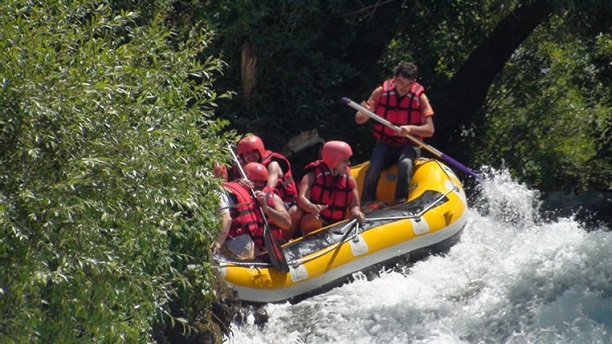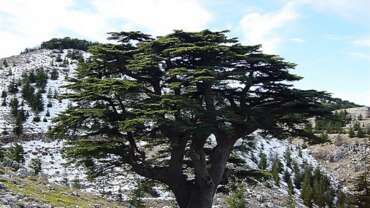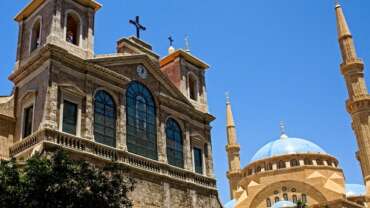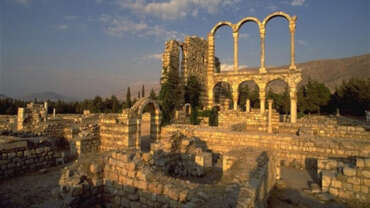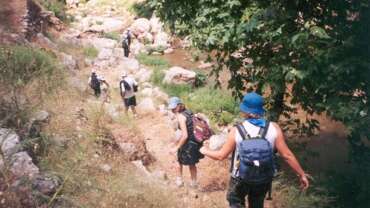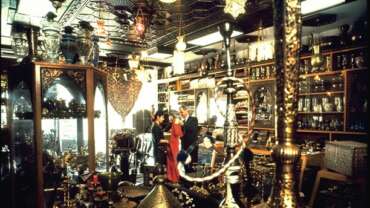Nature & Adventure Tourism of Lebanon
The blue sky and warm waters of the Mediterranean, the fresh air and rugged mountain peaks, and the pleasant chill of snowmelt-fed rivers make Lebanon a perfect destination for those who enjoy nature and the outdoors. From a leisurely afternoon of snorkeling or diving on the coast to a multiple-day trek through ancient cedar forests and mountains, the compactness of the country makes it possible to explore much of Lebanon’s natural beauty and the cultural diversity in a single trip.
In this country of rich biodiversity, nature-lovers will enjoy watching endangered loggerhead and green turtles come to shore for breeding along the southern coast or going on guided nature walks in the north in search of tiny orchids, medicinal plants, and colorful wildflowers.
With a rich variety of terrain, adventure-lovers will find any outdoor sport under the sun. In summer, many seaside and mountain resorts offer the perennial favorites, such as swimming, water-skiing, tennis, golf, and parasailing. Diving and snorkeling are is also very popular. You can explore Roman and Phoenician ruins off the coast of Saida (Sidon), Jbail (Byblos), or Sour (Tyre) or the wreckages of a World War II submarine at Khaldé, south of Beirut. In addition, ecolodges, clubs, and small outfitters offer mountain biking, guided hikes, rock climbing, rafting, archery, orienteering, and camps or other multi-day outdoor excursions throughout the year. In the winter, you can add downhill skiing, snowboarding, snowshoeing, and cross-country skiing across Lebanon’s snow-capped mountains to the list of outdoor activities.
For those seeking serious adventure and adrenaline, why not explore Lebanon from the air by paragliding or rock climbing to the more inaccessible rock-cut sanctuaries and hermitages hanging precipitously from steep mountain cliffs? Caving in Lebanon is another unique experience. Considered one of the most beautiful caves in the world, the Jeita Grotto was discovered a hundred years ago. The cave is open to the public year round. For exploration of Lebanon’s other more remote caves, many clubs and small outfitters offer tours with experienced guides and all equipment provided.
Nature Reserves
Nature reserves consist of an area of land or sea which bears an important ecological aspect and a beautiful landscape. They represent a cultural tourist and charming natural wealth devoted to protect and preserve the natural resources, especially the biological diversity. Nature reserves also represent the various ecological systems in Lebanon and constitute the main foundations of rural development policy. Besides, they are among the most important preventive means against industrial transformations, environmental deterioration, demographic growth, building expansion and the risk of wasting an important part of the country’s natural heritage together with its national wealth. That means nature reserves are considered as live witness to our national heritage, and therefore should be safeguarded for the sake of public interest and the next generations.
Lebanon includes thirteen nature reserves which constitute 3% the country’s total area. They represent a very rich biological diversity that covers around 370 species of residing and migrating birds, and over 2000 species of plants are typically Lebanese and some of them are sorted as medicinal, fragrant and nutritious. These are also around 35 species of mammals including wolves, hyenas, wildcats, porcupines and squirrels.
These nature reserves are founded and monitored under the auspices of the Ministry of Environment.
These nature reserves of Lebanon contain most of the remaining cedar forests in the country of the cedar.
The cedar forests in and out of the Lebanese nature reserves have an area of 2000 hectares distributed over nearly 12 forests and groupings among which “ Al Kamouah ” (nature protect site ), “ Ehden ” (nature reserve ), “ Bcharreh ” (nature reserve ), “ Tannourine ” (nature reserve), “ Hadath El Jebbeh” “ Jaj ”(nature reserve ), “ Ain Zhalta, Bmuhray, Barouk, Maaser El Chouf ”(nature reserve ). Plans are currently underway to join the other reserves to the national network of nature reserves in Lebanon.
The thirteen nature reserves from North to South Lebanon are:
1-Ehden Forest Nature Reserve (Horsh Ehden)
2-The Palm Islands Park and Natural reserve
3-Tannourine Cedars Forest Nature reserve
4-Mshaa Chnanir Nature Reserve
5-Bentael Nature Reserve-Jbeil
6-Yammouneh Nature reserve
7-Al- Shouf Cedar Reserve
8-Tyre Coast Nature Reserve
9-Wadi Hujeir Reserve
10-Nature reserves of “ Ramia, Kafra, Beit Leef and Debel ”, established in 2011.
In addition to nature reserves, there are 28 protected forests and 17 natural sites in Lebanon.
According to international classifications, there are 3 biosphere reserves in Lebanon which were sorted by the UNESCO during its initiative “Man and the Biosphere”. The first biosphere reserve is Al- Shouf Cedar Reserve, nominated in the year 2005, it includes the Cedars of the “ Chouf ” and the swamp of “ Ammiq ”. Later in 2007, the mountain of “Al Rihan” site was also classified as a biosphere reserve, and finally the site of “Jabal Moussa” (Moses Mount) was nominated in 2008. Moreover, there are 4 sites in Lebanon of Ramsar classification for wet lands, that bear an international importance as a refuge for aquatic birds : “ Ras Chaqaa ”, “ Ammiq ” swamp, the two nature reserves of “ Palm Islands” and “Tyre ” which also bear a Mediterranean importance, in addition to 15 important sites for birds, and 5 others that are classified in the World Heritage List, among which the “ Qadisha Valley ” that is listed as a world cultural landscape.
The protected areas, especially the nature reserves play an important role in the safeguard of natural resources, namely bio–diversity. They are also considered as a prominent factor in the local and rural development. Actually, they attract a great number of visitors who carry out eco – tourist activities, thus contributing in raising the income of local societies who live in the vital surroundings of nature reserves.
The local committees of nature reserves and their working teams undertake the management of eco–tourism activities, in coordination and cooperation with a group of partners on the national level, especially the eco-tour operators and eco–tourism firms among others. On the local level, coordination is maintained by the owners of guest houses who offer accommodation and meals to the tourists, in addition to local guides who accompany the visitors and provide them with valuable information, besides ensuring their safety.
Beaches & Sea Side
With 225 km of Mediterranean coastline extending the entire length of the country from north to south, you’ll find plenty of sun and sand in Lebanon. Beach season in Lebanon stretches from April to October, with sunny, dry weather and warm temperatures (20-32°C / 68-90°F) for swimming, sunbathing, and water sports. However, even in the winter season you will find plenty of activities to take advantage of along Lebanon’s scenic shore.
The coastline in Lebanon alternates from sandy to rocky beaches, offering an interesting variety of terrain and seaside activities. Along the coast north of Beirut, the mountains descend sharply to the Mediterranean Sea, offering spectacular vistas of rocky coastline and colorful sunsets over the water. In the south, fragrant and colorful citrus groves and banana trees line the coast, giving way to some of the country’s best-preserved and remote sandy beaches.
Lebanon’s coastline is not just for sun worshippers. Nature enthusiasts can explore the unique Mediterranean ecosystem at the Palm Islands Reserve, located 5km off the coast near Tripoli. The reserve is a prime location for observing Lebanon’s coastal flora and fauna, including sea turtles, seals, and over 300 species of migratory birds. The well-preserved beaches at the Tyre Coast Nature Reserve are also known for their rich marine and freshwater habitats.
Adventure enthusiasts will find diving, waterskiing, sailing, windsurfing, jet skiing, paragliding, and much more along Lebanon’s coast. Snorkelers can explore the magnificent submerged Phoenician and Roman ruins off the coast of the city of Sour (Tyre).
Traditional beach enthusiasts have several options to choose from in Lebanon. For those seeking full amenities and comfort, luxury resorts and beach clubs offer private beach access, swimming pools, water skiing, diving, boat rentals, nighttime entertainment, restaurants, and accommodations. Good, inexpensive public beaches with clean water and basic facilities are located in Jbail (Byblos), Chikka (near Tripoli), Batroun, and south of Sour (Tyre).
Bird Watching
Lebanon is an important stopping-off point for migratory birds along African-Eurasian migration paths, creating a wealth of bird watching opportunities, especially during the spring and fall. The peak bird watching seasons are mid-September through mid-October, and early March to mid-April.
Due to Lebanon’s diverse landscape, bird watchers are rewarded with a wide variety of species (over 300), including the rare chance to see magnificent but threatened birds such as the Imperial Eagle and the Sociable Lapwing. In addition, there are plentiful opportunities to see more common birds such as raptors, harriers, water birds, and others, like the Syrian Serin and the Palestinian Songbird.
There are three key areas for bird watchers to visit. The coastal reserves, including the Palm Islands Nature Reserve and the Tyre Coast Nature Reserve, are home to numerous sea and water birds. The mountains, with sites such as the Horsh Ehden Nature Reserve and the Al-Shouf Cedar Reserve, are known for eagles, vultures, and quails. Further inland, the marshes and plains of the Békaa Valley, such as the Aammiq Wetland, also offer plentiful bird watching opportunities. The southern village of Ibl Es-Saqi standing on the edge of a valley that function as a unique corridor passage of migrating birds is also home to a small bird sanctuary.
Trained guides are available in the nature reserves, and ecotour operators run bird watching hikes and treks through many of these beautiful areas.
Camping
More and more camping options are emerging in Lebanon, and many existing sites are simply spectacular. Campers can set up their tents overlooking the sea north of Jbail (Byblos) and walk down from their site to the Mediterranean for a swim and some snorkeling. Alternatively, campers can retire in the Adonis Valley, home of the legendary frolicking of Adonis and Aphrodite of Greek mythology.
Lebanon offers numerous campsites and ecolodges that have fully supported facilities catering to groups and families. These include platform tents or bungalow-style lodging, meals, and organized recreational activities such as hikes and mountain bike rides.
For those looking for a more remote nature experience, backcountry camping is allowed on any public land that is not in a Nature Reserve or Protected Area, but it is advisable to ask for the local authority approval, like Mayor’s permission. In these areas, camping is often part of an organized, guided excursion led by one of the country’s many ecotour operators. Camping can be a base from which to launch daytrips to nearby towns and historic attractions, for hikes in surrounding natural areas, or simply as a quiet respite from the bustle of Beirut city life.
Caving
A mountainous and rocky country composed primarily of limestone, Lebanon offers exciting opportunities for caving. Over 400 caves, caverns, and sinkholes are scattered throughout the country, offering something for everyone, from the expert spelunker to the casual tourist.
Most caves are concentrated in the Mount Lebanon region, stretching from north to south in the center of the country. The most popular and “touristy” of caves include the Jeita Grotto, with its huge caverns and underground lakes, and the enormous and intricate Afqa Grotto, source of the Adonis River where legend has it Adonis and Aphrodite exchanged their first kiss.
For the more adventurous tourists and experienced spelunkers, there are many other caving options that require guides and equipment. The Roueiss Grotto, for example, is a 5km long labyrinthine cave with an underground lake, large halls, and unique crystalline formations.
Lebanon is also home to stunning vertical caves – called “sinkholes” or “potholes” – that are some of the deepest in the Middle East (up to 602 meters). These sinkholes are explored using ropes and climbing equipment, rappelling down into the hole and then climbing back up. Lebanon’s largest sinkholes are concentrated in the northern Mount Lebanon region, especially near Laqlouq and Tannourine.
Cycling
Lebanon’s rugged mountains, hills, and valleys, and its spectacular scenery immersed in history, make for some truly unique mountain biking opportunities. Cyclists can ride up Qornet Es-Saouda (Lebanon’s highest peak) with views of the Békaa Valley to the east, Syria to the north, and the Mediterranean Sea to the west. You can also ride through rugged mountainous terrain and Cedar groves in the Horsh Ehden and Al-Shouf Cedar Nature Reserves, and at the Cedars ski resort. The high plateaus of the Mount Lebanon Range are covered with extensive trail networks, offering technically challenging terrain for seasoned cyclists.
For those looking for more relaxed cycling, the Békaa Valley and the coastal regions have many opportunities both on and off-road. Many small villages have small shops offering bike rentals for independent on-road biking.
Most mountain biking is done with a guided tour, as many mountain trails are not well marked. Several tour operators run guided cycling tours catering to all levels, and include bicycle rental, lodging, food, insurance, an experienced guide, and transportation to and from the trailhead. Some clubs also organize Beirut Bike Tours.
Hiking & Trekking
Varied terrain, scenic vistas, and historic environs combine to create unique hiking and trekking opportunities throughout Lebanon. Popular areas for hikes include the Horsh Ehden Nature Reserve near Tripoli, and the Al-Shouf Cedar Reserve, both of which offer good and extensive trail systems. Other areas with spectacular scenery and unique historical and cultural attractions include the Qadisha Valley, Makmel Park, and the remote Aakkar region in the North.
For a quintessential Lebanese experience, you can wander through the Adonis Valley, a ruggedly cut gorge sprinkled with historic ruins that is the site of Adonis and Aphrodite’s love story in Greek mythology. There are many trekking clubs and tour operators that run guided outings throughout Lebanon, ranging from leisurely day hikes to longer multi-day treks.
Mountain Climbing
Lebanon is one of the few places in the Middle East to offer a broad range of mountain climbing activities, from relatively easy summit climbs and technical peak ascents, to bouldering and adventure climbing. Limestone mountains, beautiful scenery, and easily accessible climbs welcome climbers to Lebanon.
The Aaquora, Tannourine, and Laqlouq regions have rock faces rated from 3 to 8 (on the French rating system), many of which are already bolted. There are also many interesting and technically challenging summits for mountaineering, including the 2,814 meter Mount Hermon and Mount Makmel, whose northeast face is an extremely technical climb.
Very few countries offer such great climbing located near such interesting cultural and historical attractions as Lebanon. For experienced climbers with their own equipment, topographic maps of climbing routes can be obtained from one of the country’s ecotour operators. Ecotour operators also organize a variety of guided climbing and mountaineering trips throughout the country, accessible for relatively fit travelers of all skill levels.
Skiing & Winter Sports
With six ski resorts catering to skiers and snowboarders of all skill levels, and with kilometers of backcountry Nordic cross-country and snowshoe trails waiting to be explored, Lebanon has something for everyone.
Each of the ski resorts boasts its own local flavor. For example, The Cedars Ski Resort (2,000-3,086m), near Mount Makmel (2,800m), is located on the highest range and offers the most scenic landscapes. Mzaar-Kfardebian (1,830-2,465m) is the best resort in terms of world-class infrastructure and facilities. Other resorts, such as Laqlouq (1,650-1,920m) and Qanat Bakiche (1,910-2,050m), are known for their family-oriented, friendly atmosphere. Faqra-Kfar Dibiane (1,735-1,980m) and Zaarour (1,700-2,000m) are private ski resorts, with special “peak” times reserved for members.
If you are seeking to evade the ski crowds, many outdoor adventure tour operators take groups on cross-country skiing and snowshoeing trips. Lebanon’s high plateaus are tailor-made for such Nordic pursuits.
Water Sports
With 225km of Mediterranean coastline, as well as numerous rivers throughout the country, Lebanon offers many salt- and fresh-water sporting activities. Lebanon’s rocky coastline and underwater terrain make it a unique destination for snorkeling and diving. A 600m deep underwater valley runs from Beirut to the Bay of Jounié, creating interesting rocky gorges and underwater cliffs and dropoffs for divers to explore. Another popular diving area is at Chikka (near Tripoli), which offers some of the best marine landscapes and flora and fauna off the Lebanese coast.
Exploring the underwater ruins near Jbail (Byblos), Saida (Sidon), and Sour (Tyre) is another popular activity for divers and snorkelers; however, you are required to obtain a special permit to dive near archaeological sites. There are also several world-class shipwreck sites, including “le Souffleur” (a French submarine from World War II) near Khaldé, for underwater exploration.
Lebanon’s coastline is lined with many private beach resorts and diving clubs offering facilities and equipment rentals for diving and snorkeling, as well as a variety of other water activities, including water skiing, windsurfing, and sailing. Nitrox equipment is available for technical deep-water dives.
While water sports in Lebanon are centered on the coast, there are also a number of freshwater activities, including rafting, kayaking, and canyoning. These are concentrated on the rivers of Nahr el Assi in Northern Bekaa, Nahr Litani, in the South, and Nahr Ibrahim, In Jbail, which typically swell as the spring weather melts the mountain snows, creating great deep, fast water conditions. Many ecotour operators offer guided rafting and water sport activities on Lebanon’s rivers.



